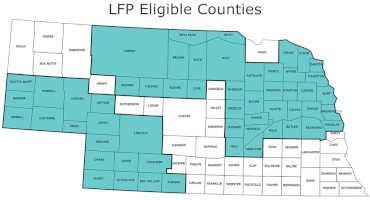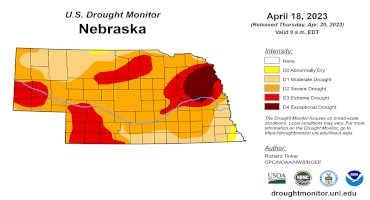
The Nebraska USDA Farm Service Agency (FSA) is highlighting available assistance programs to help farmers and livestock producers address the ongoing drought. Producers being impacted should contact their county FSA office to report losses and learn more about program options available to assist them.
“A number of Nebraska counties have drought conditions already this season that are significant enough to trigger FSA assistance programs,” said Tim Divis, the acting state executive director for Nebraska FSA. “Producers whose operations are being impacted by the drought are encouraged to learn about available programs and then contact their county FSA office for assistance.”

Drought conditions in Nebraska as of April 20, 2023. See drought status updates online at U.S. Drought Monitor.
A few key FSA drought assistance programs that have triggered in Nebraska counties include:
- Livestock Forage Disaster Program (LFP): LFP provides compensation to eligible producers who are suffering grazing losses for eligible livestock due to drought on privately-owned land, leased land where the producer has a risk in the grazing or fire on federally managed land. Producers in 55 Nebraska counties currently are eligible to apply for 2023 LFP benefits on small grains, native pasture, improved pasture or forage sorghum.
The 55 counties include: Antelope, Arthur, Banner, Blaine, Boone, Boyd, Brown, Burt, Butler, Cedar, Chase, Cherry, Cheyenne, Colfax, Cuming, Dakota, Deuel, Dixon, Dodge, Douglas, Dundy, Frontier, Furnas, Garden, Greeley, Hall, Hamilton, Hayes, Hitchcock, Holt, Hooker, Howard, Keith, Keya Paha, Kimball, Lincoln, Loup, Madison, Merrick, Morrill, Nance, Perkins, Pierce, Platte, Polk, Red Willow, Rock, Saunders, Scotts Bluff, Stanton, Thomas, Thurston, Washington, Wayne and Wheeler.
These counties became eligible for LFP due to drought status as shown on the U.S. Drought Monitor. Counties trigger for this program when they reach level D2 (drought severe) intensity for eight consecutive weeks during the normal grazing period, or when they reach D3 (drought extreme) or D4 (drought exceptional) at any time during the normal grazing period. The listing of counties that have triggered for this program is updated each Thursday when the Drought Monitor is published.
Several factors are considered regarding producer eligibility for LFP, including that a producer must have risk in both the eligible livestock and the eligible grazing lands.
- Emergency Assistance for Livestock, Honeybees, and Farm-Raised Fish Program (ELAP): ELAP is available to eligible producers who have suffered above normal expenses for hauling feed or water to livestock or hauling livestock to forage/grazing acres due to the impacts of drought.
All counties in Nebraska have triggered for this program, except for Johnson, Nemaha, Pawnee, Richardson and Webster. These counties became eligible for ELAP due to drought status as shown on the U.S. Drought Monitor. Counties trigger for this program when they reach level D2 (drought severe) intensity for eight consecutive weeks, with the last week having to be inside of the normal grazing season, or reach D3 (drought extreme) or greater.
Producers must have risk in both eligible livestock and eligible grazing land in an eligible county to qualify for ELAP assistance. For ELAP losses, producers must submit a notice of loss to the FSA office within 30 calendar days of when the loss is apparent; producers in eligible counties should contact their county FSA office as soon as the loss of water resources or feed resources are known.
For ELAP eligibility, documentation of expenses is critical. Producers should maintain records and receipts associated with the costs of transporting water to eligible livestock, the costs of transporting feed to eligible livestock, and the costs of transporting eligible livestock to forage/grazing acres.
ELAP also has available assistance provisions for honeybee producers impacted by drought, and those producers should contact the county FSA office for more information.
- Conservation Reserve Program (CRP) Emergency Haying and Grazing: Acres enrolled in the Conservation Reserve Program may be authorized for emergency haying and grazing to provide additional hay resources for livestock producers affected by drought. Counties trigger for this emergency program by reaching D2 (drought severe) on the U.S. Drought Monitor or in a county where there is at least a 40% loss in forage production. Producers interested in haying or grazing of CRP acres must contact the county FSA office to determine eligibility prior to beginning any haying or grazing activity and to gain an understanding of specific program provisions.
- Emergency Loan Program: This program provides emergency loans to qualified producers to help with production and physical losses related to drought. These loans can be used to assist with production costs for the disaster year, essential family living expenses, reorganizing the farm operation or refinancing certain debts. Among other eligibility requirements, farmers and ranchers who apply for these loans must be unable to receive credit from commercial sources.
This program has triggered in 55 Nebraska counties that received a USDA Secretarial primary drought disaster designation and an additional 23 Nebraska counties that border the disaster-declared counties. The disaster designations are based on conditions shown on the U.S. Drought Monitor. Producers have until Dec. 1, 2023, to apply for these loans.
Other assistance programs that may be available to assist producers with drought impacts include the Emergency Conservation Program (ECP) to aid with expenses associated with pasture water resources, and the Tree Assistance Program (TAP) to replant or rehabilitate eligible trees, bushes or vines lost during the drought.
The Noninsured Crop Disaster Assistance Program (NAP) provides financial assistance to producers of non-insurable crops to protect against natural disasters that result in lower yields or crop losses, or prevents crop planting. NAP coverage must have been purchased by the application closing date ahead of the growing season. Producers with NAP coverage for 2023 crops are reminded they must file Notice of Loss with FSA when a crop or planting is affected by natural disaster. The filing deadline varies by crop, and producers should contact their county FSA office for details.
FSA also has a variety of loan servicing options available for borrowers who are unable to make scheduled payments on their farm loan debt to FSA because of reasons beyond their control. This includes the Disaster Set-Aside Program.
Source : unl.edu